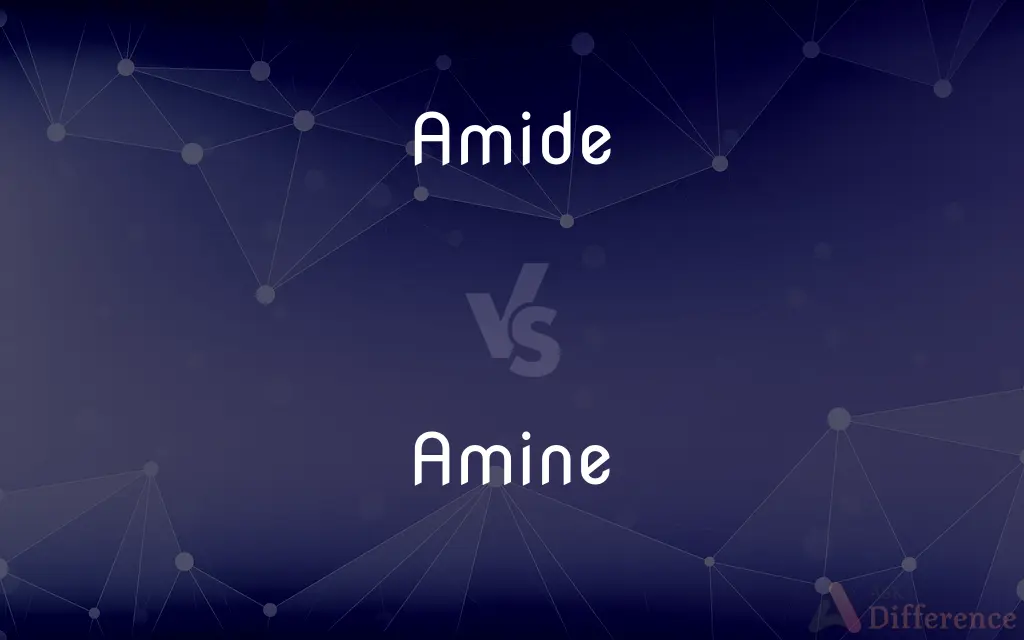Amide vs. Amine — What's the Difference?
By Tayyaba Rehman — Updated on October 3, 2023
Amide" is an organic compound containing a carbonyl group linked to nitrogen, while "Amine" is an organic compound derived from ammonia by replacement of one or more hydrogen atoms by organic groups.

Difference Between Amide and Amine
Table of Contents
ADVERTISEMENT
Key Differences
Amide and Amine are both fundamental terms in organic chemistry, representing different classes of nitrogen-containing compounds. Amide has a carbonyl group (C=O) bonded to a nitrogen atom, while Amine doesn't.
In structure, Amides possess a double bond between the carbon and oxygen of the carbonyl group, directly linked to a nitrogen atom. On the other hand, Amines consist of a nitrogen atom bonded to hydrogen atoms or organic groups.
Functionally, Amides are less reactive compared to other carbonyl compounds due to the resonance between the carbonyl bond and the nitrogen. Amines, in contrast, are basic in nature and can engage in various reactions due to the lone pair of electrons on the nitrogen atom.
A classic example of an Amide is acetamide. It's less basic than Amines like methylamine because the lone pair of electrons on the nitrogen in amides is delocalized with the carbonyl group.
In biological systems, Amides are seen in the peptide bonds that link amino acids in proteins. Amines, meanwhile, are key components in amino acids, neurotransmitters, and many biologically active molecules.
ADVERTISEMENT
Comparison Chart
Functional Group
Carbonyl group (C=O) linked to a nitrogen atom.
Nitrogen bonded to hydrogen/alkyl groups.
Reactivity
Less reactive due to resonance.
Basic, and more reactive.
Presence in Nature
Found in proteins as peptide bonds.
Found in amino acids and neurotransmitters.
Example
Acetamide
Methylamine
Basicity
Less basic.
More basic.
Compare with Definitions
Amide
Less basic compared to amines.
Due to resonance, the nitrogen in an amide is less basic than in amines.
Amine
Contains a nitrogen atom bonded to hydrogen atoms or alkyl groups.
In ethylamine, the amine nitrogen is bonded to two hydrogen atoms and an ethyl group.
Amide
Contains a carbonyl group directly bonded to a nitrogen atom.
The structure of the amide group includes a carbon atom double-bonded to an oxygen atom and singly bonded to a nitrogen.
Amine
Found in amino acids and many biological molecules.
Dopamine, a neurotransmitter, contains an amine group.
Amide
Typically named by replacing the acid suffix with -amide.
From benzoic acid, we get the amide named benzamide.
Amine
An organic compound derived from ammonia.
Methylamine is an amine where one hydrogen of ammonia is replaced by a methyl group.
Amide
An organic compound derived from a carboxylic acid and an amine.
Acetamide is a simple amide derived from acetic acid.
Amine
Acts as a base due to the lone pair of electrons on the nitrogen.
An amine can accept a proton because of the lone electron pair on the nitrogen.
Amide
In organic chemistry, an amide ( or or (listen), also known as an organic amide or a carboxamide, is a compound with the general formula RC(=O)NR′R″, where R, R', and R″ represent organic groups or hydrogen atoms. The amide group is called a peptide bond when it is part of the main chain of a protein, and an isopeptide bond when it occurs in a side chain, such as in the amino acids asparagine and glutamine.
Amine
In organic chemistry, amines (, UK also ) are compounds and functional groups that contain a basic nitrogen atom with a lone pair. Amines are formally derivatives of ammonia, wherein one or more hydrogen atoms have been replaced by a substituent such as an alkyl or aryl group (these may respectively be called alkylamines and arylamines; amines in which both types of substituent are attached to one nitrogen atom may be called alkylarylamines).
Amide
An organic compound containing the group —C(O)NH₂, derived from ammonia by replacement of a hydrogen atom by an acyl group.
Amine
An organic compound derived from ammonia by replacement of one or more hydrogen atoms by organic groups.
Amide
An organic compound, such as acetamide, containing the CONH2 group.
Amine
Any of a group of organic compounds of nitrogen, such as ethylamine, C2H5NH2, that may be considered ammonia derivatives in which one or more hydrogen atoms have been replaced by a hydrocarbon group.
Amide
The anion of ammonia, NH2- or a compound containing this anion, such as sodium amide, NaNH2.
Amine
(inorganic chemistry) A functional group formally derived from ammonia by replacing one, two or three hydrogen atoms with hydrocarbon or other radicals.
Amide
(organic chemistry) Any derivative of an oxoacid in which the hydroxyl group has been replaced with an amino or substituted amino group; especially such derivatives of a carboxylic acid, the carboxamides or acid amides
Amine
(organic chemistry) Any organic compound containing an amine functional group.
Amide
(inorganic chemistry) Any ionic derivative of ammonia in which a hydrogen atom has been replaced with a metal cation (R-NH- or R2N-) Category:en:Nitrogen
Amine
One of a class of basic substances derived from ammonia by replacement of one or more hydrogen atoms by an alkyl or aryl group. Compare amide, in which an acyl group is attached to the nitrogen. Hydroxylamine and hydrazine, which are not an organic compounds, are also basic and may also be considered amines.
Amide
A compound formed by the union of amidogen with an acid element or radical. It may also be regarded as ammonia in which one or more hydrogen atoms have been replaced by an acid atom or radical.
Amine
A compound derived from ammonia by replacing hydrogen atoms by univalent hydrocarbon radicals
Amide
Any organic compound containing the group -CONH2
Amine
Categorized as primary, secondary, or tertiary.
Methylamine is a primary amine because it has one organic group attached to the nitrogen.
Amide
Found in the peptide bonds of proteins.
Proteins are made up of amino acids linked by amide bonds.
Common Curiosities
Which one is more basic, Amide or Amine?
Amines are more basic than Amides.
Can Amines act as bases?
Yes, Amines can act as bases due to the lone pair of electrons on the nitrogen atom.
How are Amides formed?
Amides are typically formed by the reaction of carboxylic acids with amines or ammonia.
How can Amines be categorized?
Amines can be categorized as primary, secondary, or tertiary based on the number of organic groups attached to the nitrogen.
Is the nitrogen in Amides delocalized?
Yes, the lone pair of electrons on the nitrogen in Amides is delocalized with the carbonyl group, making it less basic.
What makes Amides less reactive than other carbonyl compounds?
The resonance between the carbonyl bond and the nitrogen atom in Amides makes them less reactive.
Are Amines found in neurotransmitters?
Yes, many neurotransmitters like dopamine and serotonin contain Amine groups.
Is acetamide an Amide or an Amine?
Acetamide is an Amide.
Are Amides found in proteins?
Yes, Amides are present in proteins as peptide bonds linking amino acids.
Is the carbonyl group present in Amines?
No, the carbonyl group is characteristic of Amides, not Amines.
Do both Amides and Amines contain nitrogen?
Yes, both Amides and Amines contain nitrogen atoms in their structure.
How do you name Amides in IUPAC nomenclature?
In IUPAC nomenclature, Amides are typically named by replacing the acid suffix of the parent carboxylic acid with -amide.
Are all Amines derivatives of ammonia?
Yes, Amines are derived from ammonia by replacing one or more hydrogen atoms with organic groups.
Do Amines participate in hydrogen bonding?
Yes, Amines can participate in hydrogen bonding due to the presence of the nitrogen atom.
What is a secondary Amine?
A secondary Amine has two organic groups attached to the nitrogen atom and one hydrogen.
Share Your Discovery

Previous Comparison
Sequel vs. Prequel
Next Comparison
Sicked vs. SiccedAuthor Spotlight
Written by
Tayyaba RehmanTayyaba Rehman is a distinguished writer, currently serving as a primary contributor to askdifference.com. As a researcher in semantics and etymology, Tayyaba's passion for the complexity of languages and their distinctions has found a perfect home on the platform. Tayyaba delves into the intricacies of language, distinguishing between commonly confused words and phrases, thereby providing clarity for readers worldwide.
















































